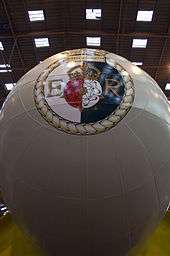HMS Queen Elizabeth (R08)
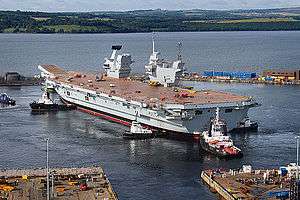 HMS Queen Elizabeth being launched in July 2014 | |
| History | |
|---|---|
| Name: | Queen Elizabeth |
| Namesake: | Queen Elizabeth I[1] |
| Operator: | Royal Navy |
| Ordered: | 20 May 2008 |
| Builder: | |
| Cost: | £3.1bn[2] (~US$5bn) |
| Laid down: | 7 July 2009[3] |
| Launched: | 17 July 2014 |
| Sponsored by: | Elizabeth II |
| Christened: | 4 July 2014 |
| Commissioned: | May 2017 (planned)[4] |
| In service: | 2020 (planned)[5] |
| Homeport: | HMNB Portsmouth |
| Identification: |
|
| Motto: | Semper Eadem ("Always the Same") |
| Status: | Fitting Out |
| Badge: |
 |
| General characteristics | |
| Class and type: | Queen Elizabeth-class aircraft carrier |
| Displacement: | 70,600 tonnes (69,500 long tons; 77,800 short tons)[6][7][8] |
| Length: | 280 m (920 ft)[9] |
| Beam: |
|
| Draught: | 11 metres[10] |
| Decks: | 16,000 square metres |
| Speed: | 25 knots (46 km/h) |
| Range: | 10,000 nautical miles (19,000 km)[5] |
| Capacity: | 1,600[11] |
| Troops: | 250[11] |
| Complement: | 679[12] |
| Sensors and processing systems: |
|
| Armament: |
|
| Aircraft carried: |
|
| Aviation facilities: | Hangar below deck and two aircraft lifts. |
HMS Queen Elizabeth is the lead ship of the Queen Elizabeth-class of aircraft carrier, the largest warship ever built for the Royal Navy and capable of carrying up to forty aircraft. She was named by Queen Elizabeth II on 4 July 2014, and is scheduled to be formally commissioned in May 2017,[4] with initial operational capability from 2020. Her first Commanding Officer is to be Commodore Jerry Kyd, the former captain of HMS Ark Royal and HMS Illustrious.[13]
Unlike most large carriers she is not fitted with catapults and arrestor wires and is instead designed to operate V/STOL aircraft; her air wing will typically consist of F-35B Lightning II fighter-bombers and Merlin helicopters for airborne early warning and anti-submarine warfare. The design emphasises flexibility, with accommodation for 250 Royal Marines and the ability to support them with attack helicopters and troop transports up to Chinook size and larger. She is the second Royal Navy vessel to bear the name HMS Queen Elizabeth and is to be based at HMNB Portsmouth.[14]
Design and construction
On 25 July 2007, the then Defence Secretary Des Browne, announced the order for two new carriers.[15] At the time of approval the first carrier was expected to enter service in July 2015 and the budget was £4,085m for two ships.[16] The financial crisis led to a political decision in December 2008 to slow production, delaying Queen Elizabeth until May 2016. This decision alone added £1,560m to the cost.[16] By March 2010 the budget was estimated at £5,900m[16] and in November 2013 the contract was renegotiated with a budget of £6,200m.[17] The in-service date was further extended to 2020 in the Strategic Defence and Security Review in October 2010.[18]
Construction of Queen Elizabeth began in 2009. Her assembly is taking place in the Firth of Forth at Rosyth Dockyard from nine blocks built in six UK shipyards: BAE Systems Surface Ships in Glasgow, Babcock at Appledore, Babcock at Rosyth, A&P Tyne in Hebburn, BAE at Portsmouth and Cammell Laird (flight decks) at Birkenhead.[19][20] Two of the lower main blocks, together weighing more than 6,000 tonnes and forming part of the base of the ship, were assembled and joined into one piece on 30 June 2011.[21] On 16 August 2011, the 8,000-tonne Lower Block 03 of Queen Elizabeth left BAE Systems Surface Ships' Govan shipyard in Glasgow on a large ocean-going barge. Travelling 600 miles (970 km) around the northern coast of Scotland, the block arrived at Rosyth on the evening of 20 August 2011.[22] On 28 October 2012, an 11,000-tonne section of the carrier began a lengthy journey around the south coast of England (to avoid bad weather) from the shipbuilding hall at Govan, to the Rosyth dockyard; it arrived on 21 November.[23] Her forward island was built at BAE Portsmouth and attached on 14 March 2013; the aft island was attached in June 2013. The ski jump was added in November 2013,[11] leaving just the elevators and radar to be lifted into place.[11] As of September 2013, Queen Elizabeth was 80% complete internally.[12]
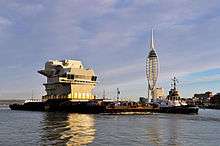

Naming ceremony
Queen Elizabeth was named at Rosyth on 4 July 2014, by Elizabeth II, who said that the warship "marks a new phase in our naval history". Instead of smashing the traditional bottle of champagne on the hull, she smashed a bottle of whisky from the Bowmore distillery on the Scottish island of Islay.
The ceremony was attended by the Duke of Edinburgh (the Lord High Admiral), Admiral George Zambellas (First Sea Lord), senior naval officers from the United States and France, and by politicians including David Cameron and Gordon Brown (the Prime Minister and his immediate predecessor) and Alex Salmond (First Minister of Scotland at that time).
It also featured a fly-past by the Red Arrows and a second comprising navy, air force and army helicopters. HMS Illustrious was berthed adjacent to Queen Elizabeth during the ceremony.[24]
The ship was floated out of dry dock on the morning of 17 July 2014.[25]Fitting out was completed at the end of 2015 and the crew moved aboard in May 2016. On 24 May 2016, Commodore Jeremy Kyd assumed command of the ship from Captain Simon Petitt.[26]
Future work
Sea trials are planned beginning in March 2017 and delivery expected in May 2017.[11][25] Prior to the ship's departure from Rosyth, an extensive survey was carried out of the Firth of Forth by HMS Gleaner and 42 Regiment, Royal Engineers to gather information on the tides, the depth of the river bed, and the height of the three river crossings (Forth Bridge, Forth Road Bridge, Queensferry Crossing). This was necessary as the most recent data available was 60 years old.[27] Flight trials with helicopters will begin in 2017 and F-35B flight trials towards the end of 2018.[25] An "operational military capability" will be declared in 2020.[28]
Aircraft
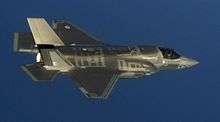
The two ships of the Queen Elizabeth class (the other being HMS Prince of Wales) are each expected to be capable of carrying forty aircraft, a maximum of thirty-six F-35s and four helicopters.[29] The 2010 SDSR anticipated the routine deployment of twelve F-35Bs, but a typical warload will be 24 F-35Bs and some helicopters.[12] These could be a Maritime Force Protection package of nine anti-submarine Merlin HM2 and five Merlin Crowsnest for airborne early warning; alternatively a Littoral Manoeuvre package could include a mix of RAF Chinooks, Army Apaches, Merlin HC4 and Wildcat HM2.[12] As of September 2013 six landing spots are planned, but the deck could be marked out for the operation of ten medium helicopters at once, allowing the lift of a company of 250 troops.[12] The hangars are designed for CH-47 Chinook operations without blade folding and for the V-22 Osprey tiltrotor, whilst the aircraft lifts can accommodate two Chinooks with unfolded blades.[30]
Weapons systems
Defensive weapons include the Phalanx Close-In Weapons System for anti-aircraft and anti-missile defence; also 30mm Automated Small Calibre Guns and Miniguns for use against fast attack craft.[5]
Highly Mechanised Weapon Handling System (HMWHS)
Incorporated into the first two blocks is a sophisticated handling and deployment system for air weapons, with the aim of achieving a sortie generation rate which is about six times faster than any previous Royal Navy aircraft carrier. The system requires only 50 people and could be operated with as few as 12 in an emergency; it is estimated that 160 would be needed to produce the same efficiency with conventional equipment. The system moves munitions on pallets by means of remotely controlled electric vehicles and lifts.[31]
Affiliations
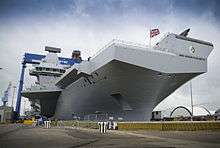
Official affiliations
See also
Coordinates: 56°1′30.59″N 3°26′56.64″W / 56.0251639°N 3.4490667°W
References
- ↑ "Inside HMS Queen Elizabeth: The construction of the Royal Navy's largest ever vessel". The Independent. 17 June 2014. Retrieved 15 May 2016.
- ↑ As of November 2013 the official project cost for the two carriers is £6.2bn
- ↑ "Work begins on aircraft carriers". BBC News. 7 July 2009. Retrieved 11 March 2011.
- 1 2 "HMS Queen Elizabeth crew switch on its radar for first time". Naval Technology. Retrieved 29 August 2015.
- 1 2 3 4 "Key facts about the Queen Elizabeth Class" (PDF). Aircraft Carrier Alliance.
- ↑ Harris, Stephen (27 May 2014). "Your questions answered: HMS Queen Elizabeth aircraft carrier". The Engineer.
- ↑ "Progress being made but uncertainties remain", WarShip Technology: July/Aug 2013, The Royal Institution of Naval Architects
- ↑ "Queen Elizabeth class aircraft carrier: A Guide". UK Defence Journal. 3 April 2014. Retrieved 14 November 2014.
- ↑ "Queen Elizabeth Class". Royal Navy. Retrieved 12 August 2013.
- ↑ Future Aircraft Carrier (CVF) MOD website. retrieved 21 May 2008
- 1 2 3 4 5 Hargreaves, Richard (December 2013). "Asset management". Navy News. p. 8.
- 1 2 3 4 5 Osborne, Anthony (11 September 2013). "U.K. Royal Navy Widening Scope of Carrier Use". Aviation Week.
- ↑ "Royal Navy Appoints First Captain of HMS Queen Elizabeth". Royal Navy. 27 February 2014. Retrieved 27 February 2014.
- ↑ "MOD confirms carrier order". BBC News. Retrieved 11 December 2008.
- 1 2 3 "Ministry of Defence Major Projects Report 2010 HC489-I" (pdf). House of Commons Defence Committee. 15 October 2010. p. 7 and fig 3.
- ↑ "House of Commons Hansard Debates for 06 Nov 2013 (pt 0001)". UK Parliament. 6 November 2013. Retrieved 3 January 2014.
- ↑ "Securing Britain in an Age of Uncertainty: The Strategic Defence and Security Review" (PDF). HM Government. 19 October 2010. Retrieved 19 October 2010.
- ↑ "Cammell Laird wins £50m Royal Navy warship contract". Liverpool Echo. 25 January 2010. Retrieved 25 January 2010.
- ↑ Construction begins at Navy's new carriers' Portsmouth base
- ↑ "Another giant piece of the carrier slots into place". Navy News.
- ↑ "Huge carrier block arrives in Rosyth". Navy News. 22 August 2011. Retrieved 29 December 2011.
- ↑ Navy News – Gigantic piece of HMS Queen Elizabeth arrives to join the rest of the ship – 12/11/2012
- ↑ "Queen names new Royal Navy aircraft carrier in Rosyth". BBC News. 4 July 2014. Retrieved 4 July 2014.
- 1 2 3 Osborne, Tony (17 July 2014). "U.K. Carrier Floated for the First Time". Aviation Week.
- ↑ First sea captain joins Royal Navy’s newest aircraft carrier, Royal Navy, 24 May 2016
- ↑ "Navy's smallest ship paves way for maiden voyage of its largest". Royal Navy. 2 September 2016. Retrieved 2 September 2016.
- ↑ House of Commons Hansard Debates for 10 May 2012, UK Parliament, 10 May 2012
- ↑ Adams, Christopher (25 July 2007). "MoD gives nod for aircraft carriers". Financial Times. Retrieved 19 September 2013.
- ↑ Osborne, Anthony (30 August 2013). "U.K. Builds Fleet of Modernized Chinooks". Aviation Week.
- ↑ Downs, David (1 March 2012). "Assembly phase reveals Queen Elizabeth scale". The Engineer.
- ↑ "Royal Navy and City of London affirm bonds with new aircraft carrier". Royal Navy. 9 June 2014. Retrieved 25 November 2015.
External links
| Wikimedia Commons has media related to HMS Queen Elizabeth (R08). |
- Royal Navy HMS Queen Elizabeth Class (royalnavy.mod.uk)
